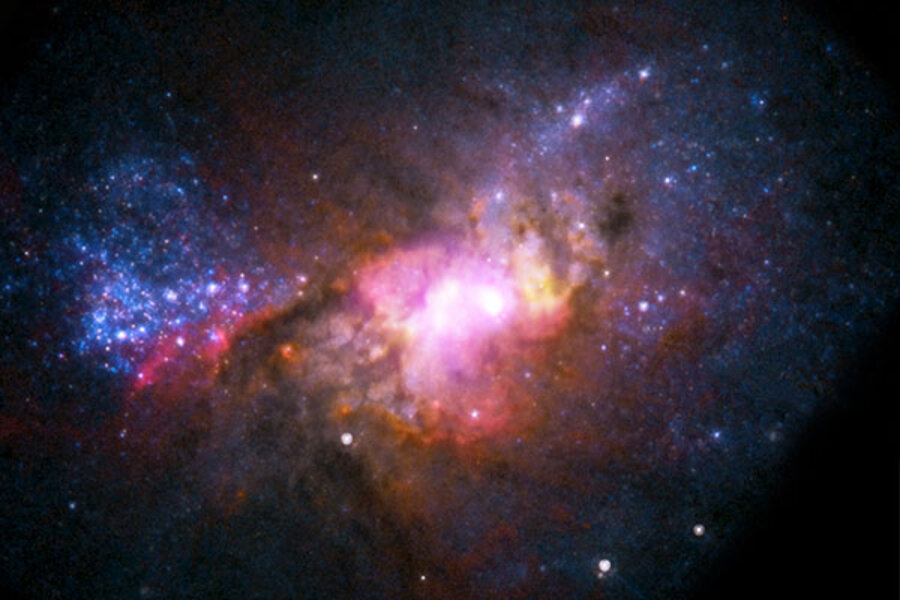'Missing link' black holes could be hiding in dwarf galaxies
Loading...
In the first cosmic survey of its kind, astronomers have uncovered active medium-mass black holes of the sort that some theories suggest could be "seeds" that eventually grow into the supermassive black holes at the centers of large galaxies like our Milky Way.
The discovery of medium-mass black holes in the new survey came as something of a surprise. They were found in dwarf galaxies, which were long thought to host few if any central black holes. Scientists currently understand how the smallest, stellar-mass black holes form but have been looking for medium-mass black holes as a "missing link" between stellar black holes and the supermassive varieties.
Followup observations could provide fresh insights on the influence such black holes can have on the evolution of their host galaxies, as well as on the evolution of the early universe itself.
The finding points to a paradigm shift. "Only full-size, massive galaxies like the Milky Way were thought to host central black holes," said Amy Reines, an astronomer with the National Radio Astronomy Observatory in Charlottesville, Va., during briefing in Washington Wednesday describing the results.
Black holes are objects whose gravity is so intense that not even light can escape their grasp. So-called stellar black holes form from stars several tens of times more massive than the sun, which end their lives in powerful explosions known as supernovae.
These can yield black holes ranging from about three solar masses to a few tens of solar masses – a far cry from the behemoths in the hearts of massive galaxies. Supermassive black holes range from millions to billions of solar masses, with the most massive black holes found in the most massive galaxies.
These enormous galaxies tip the scales at trillions of solar masses. Dwarf galaxies, by contrast, are galactic munchkins that tip the scales at around 10 billion solar masses. The Large Magellanic Cloud, which appears over the southern hemisphere, is one example of a galactic dwarf.
Many galaxies in this mass range in the local universe are thought to be similar to fledgling galaxies that populated the cosmos during the first several hundred million years after the universe was born some 13.8 billion years ago in a sudden release of energy known as the Big Bang.
Observations of galaxies in the early universe have suggested that supermassive black holes didn't form from stellar-mass black holes but from objects more massive. Might today's dwarf galaxies hold some of those objects?
Many researchers thought not, largely because dwarf galaxies are faint and a middleweight black hole would be of such low mass that its effects on its surroundings would difficult to detect.
Moreover, studies of larger galaxies and their central black holes had found a relationship between the mass of a central black hole and the presence and mass of a central bulge of stars that hid it. Many dwarf galaxies have irregular shapes and no central bulge, Dr. Reines said in an interview. So they didn't look to be promising targets for a black-hole search.
Other researchers had hunted for these mid-mass central black holes in a variety of galaxy types but with inconclusive results.
In 2011, however, Reines and colleagues reported detecting a massive black hole of roughly 1 million solar masses at the heart of a dwarf galaxy some 34 million light-years way.
The galaxy, Henize 2-10, was forming new stars at a ferocious rate and had no central bulge. But its black hole was gorging matter around it with enough gusto to generate radiation that Reines and colleagues detected via X-ray and radio telescopes.
That prompted Reines and colleagues to hunt more systematically for evidence of similarly active massive black holes in dwarf galaxies. They selected 25,000 dwarfs and found 151 hosted central black holes. The black holes' masses ranged from about 100,000 to 1 million solar masses, with the average about 200,000 solar masses, the team estimates.
Although 151 out of 25,000 is a small number, the count likely underestimates the total because the team found data only for the galaxies with the most active central black holes at the time the images were taken, Reines said. Central black holes don't feed all the time. Many of the other galaxies in the original sample may host central, massive black holes that are snoozing between meals.
The number of dwarf galaxies hosting black holes is important because it can provide a test of competing ideas about how such welterweight black holes form.
For instance, if such black holes are common in dwarf galaxies, they probably originated from mergers of stellar black holes created when the universe's initial population of massive hot stars exploded at the end of their lives. If the middleweights in dwarf galaxies are rare, that would favor formation from the collapse of a gas cloud whose initial mass was large enough to drive it straight to black-hole status without becoming a star first.
In addition to offering clues about the origins of seeds for supermassive black holes, these dwarfs and their central engines may help explain processes that ended the universe's dark age. This was a period after the Big Bang when molecular hydrogen permeated the universe, preventing light from illuminating the cosmos. Active welterweight black holes in the centers of fledgling galaxies may have helped ionize the hydrogen, helping lift the hydrogen fog.
Studies of the behavior and radiation output from central black holes in local dwarf galaxies could provide crucial details on the physics driving this period of re-ionization, Reines's team suggests.








